Broadcast area Chicago market Power 50,000 Watts Frequency 1000 kHz Area Chicago metropolitan area | First air date June 19, 1926 Class A (Clear channel) City of license Chicago Slogan The Voice of Labor | |
 | ||
Callsign meaning Chicago Federation
of Labor Format Top 40, Religion, Middle of the road, Variety Owner Chicago Federation of Labor, Mutual Broadcasting System Branding Big 10 WCFL, SuperCFL, Mutual/CFL | ||
WCFL (1000 AM) was the callsign of a commercial radio station in Chicago, Illinois, United States. It was owned by the Chicago Federation of Labor, hence its call letters. The station is now known as WMVP. Its transmitter is located in Downers Grove and is still in use by WMVP. The station billed itself as "The Voice of Labor" from its inception until its sale to Mutual in 1978.
Contents
- Early years
- Television WCFL FM and evolution to Top 40
- Top 40 at the Voice of Labor
- The end of Super CFL and the sale to Mutual
- Religious years and end
- WCFL on internet radio
- References

Early years

In 1922, the American Federation of Labor began discussions regarding owning and operating its own radio station. By 1925, the AFL decided not to enter the broadcasting business but to purchase time for organized labor's message on commercially operated radio. The dream stayed alive with the Chicago Federation of Labor, who believed having an owned and operated radio station would be an effective way to spread its message. In 1924, the Federation gave its approval to work toward establishing a radio station. The original plan for WCFL called for it to be a non-commercial station, operating on the support of its listeners; in a sense it was one of the first large-scale efforts at public radio. Spearheading the drive to make WCFL a reality was the Federation's Secretary, Edward Nockels (1869–1937); without his efforts, there would have been no radio station at all.
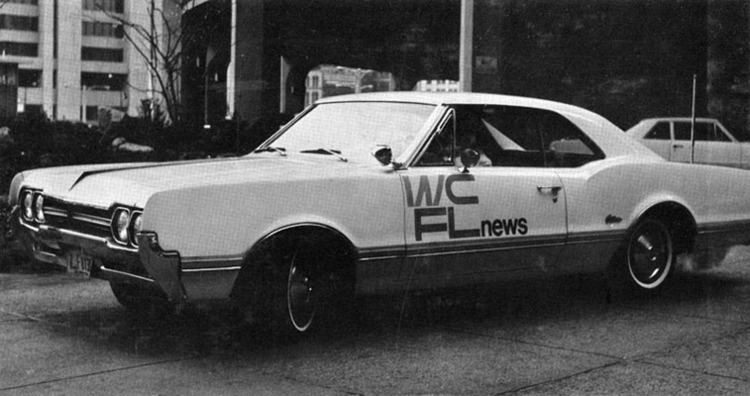
WCFL officially began on December 4, 1925; the Federation's hopes were temporarily dashed when the US Department of Commerce (there was no Federal Communications Commission until 1934 and no Federal Radio Commission which preceded it until 1927) refused to grant WCFL a wavelength on January 13, 1926. Just five days after what could have become an end to the station, the Federation announced it would go ahead with building it anyway.
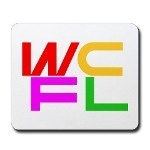
The first WCFL transmitter stood on Chicago's Navy Pier (then called Municipal Pier); the Federation was able to lease the pier's North Tower for 10 years at $1 per year and its willingness to make WCFL available for city broadcasts. Initially the Illinois Manufacturers' Association attempted to keep WCFL off the air by protesting the use of public property for the station's transmitter and broadcasting site. The station purchased the land in Downers Grove where the current transmitter operates in 1928 and broke ground there in 1932. The Federation originally purchased 100 acres (0.40 km2) of land in the western suburb; 20 of them were allotted for the WCFL transmitter, while the other 80 were subdivided as lots for 258 homes and 72 businesses in "WCFL Park". Nockels believed having a union-based community spring up around the WCFL transmitter would be beneficial to both those purchasing lots and building homes and to the station itself. The labor union entered the real estate business shortly before the Depression hit. After selling no lots in the early part of the 1930s, the Federation put WCFL Park on hold, reviving it again in 1939 with the building of a model home on one of the lots, all of which would eventually be divested.
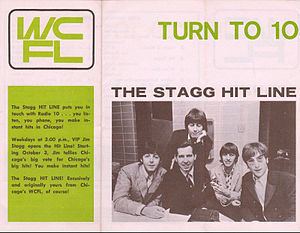
AM 1000 began operation as WCFL in test broadcasts on June 19, 1926; the Commerce Department granted it call letters on July 10, 1926. It was officially on the air the next day at 610 KC with 1,000 watts of power, one of the last non-profit radio stations to take to the airwaves. The first broadcast consisted of two hours of music. In November 1926, with an eye toward being self-sustaining, the Federation added a shortwave station to the Navy Pier transmitter site, planning to use WCFL Radio Telegraph to help offset broadcasting costs. The station initially used studios at Navy Pier, but during the winter of 1926–1927 found that the weather often made them inaccessible. By March 1927, WCFL was broadcasting from 623 South Wabash in Chicago (today the home of Columbia College, Chicago,) producing a quarterly radio magazine, and operating on 620 KC—the frequency being shared with the Lane Tech High School radio station. In 1928, WCFL applied to the Federal Radio Commission for an increase in its transmitter power and hours of operation. Several other radio stations were now also operating on the 620 KC frequency along with WCFL and the Lane Tech station. The commission disagreed with the reasoning that such increases were necessary to serve union members. Further, it cut the operating power of WCFL to only 1,500 watts. General Order 40 brought WCFL to the 970 KC frequency, shared with KJR in Seattle, still at 1,500 watts and now allowed to operate in daylight only. The Federal Radio Commission had labeled the station as a "propaganda" type, not truly worthy of a license; it would take some years of expensive discussions to attain clear-channel, 50,000-watt status.

While the original idea of a self-supporting WCFL was based on each Federation member's donation of $1 a year for all station operating expenses, by 1926, 30% of the membership had donated. The donations continued to spiral downward as time passed, especially after 1928, when WCFL's operating power was cut and it was limited to "dawn to dusk" broadcasting—from sunrise to sunset. The dawn-to-dusk operation limitations were lifted in 1929, but there was still no clear channel yet for WCFL. 1929 found the station notifying the Federation that unless members made their dollar donations, WCFL would need to implement some type of commercial broadcasting to stay afloat. This was the reason why the transmitter land had been purchased in 1928, but no construction was able to be done on the Downers Grove transmitter site until 1932. By 1930, commercials had become a reality on WCFL; the station did not show a profit until 1940. By 1945, WCFL had moved to the 1,000 KC position on the dial (from previously being at 770 and 970 KC ) and was a 50,000-watt clear-channel station; records of a year earlier show that previously the station had only progressed to having 10,000 watts.
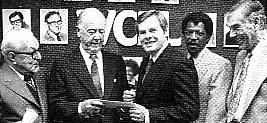
In 1927, WCFL broadcast the Gene Tunney-Jack Dempsey championship boxing match at Soldier Field, challenging the National Broadcasting Company's exclusive claim to the event. This led to an arrangement whereby WCFL became one of three affiliates in Chicago of the Blue Network of NBC; WCFL broadcast non-sponsored, or sustaining, NBC programs not carried by WENR or WLS, as well as selected major sporting events and any broadcast speeches by union leaders aired by the network. WCFL became a member of the Mutual Broadcasting System in December 1949. When the Federal Communications Commission forced NBC to sell the Blue Network, WCFL's affiliation continued with the network through its new identity as the American Broadcasting Company, ending with the merger of WENR and WLS in 1959. Prior to this, the station offered selected programming from the network. WCFL was also to become an affiliate of the Amalgamated Broadcasting System in 1933, but that network collapsed after only a month of operations, prior to its planned westward expansion from New York. The usual broadcast day included dance and classical music, comedy, as well as radio programs in 11 different languages designed to reach out to Chicago's immigrant population.
Television, WCFL-FM, and evolution to Top 40

WCFL was also involved in early experimental television broadcasts, and operated a shortwave repeater station, W9XAA, in the 1930s. This was the first television station in Chicago. On June 19, 1928, Ulises Armand Sanabria, a local television pioneer, made the first Chicago television broadcast using the WCFL Navy Pier transmitter to send the video portion of the signal and Chicago radio station WIBO for the audio portion. Those with receivers were able to see a head and shoulders view of Edward Nockels, the Federation secretary and driving force behind WCFL. It's also possible the broadcast was simulcast by the WCFL shortwave station, W9XAA. Accounts of later broadcasts at WMAQ specify their shortwave station was used for this purpose. As the Federation tried to revive their "WCFL Park" real estate project near the Downers Grove transmitter, the decision was made to abandon W9XAA in 1937, preferring to concentrate on gaining more transmitter power for WCFL. New Federal Communications Commission rules insisted that shortwave stations have a minimum of 5,000 watts of power; the cost to WCFL to upgrade to this level would have been around $10,000.
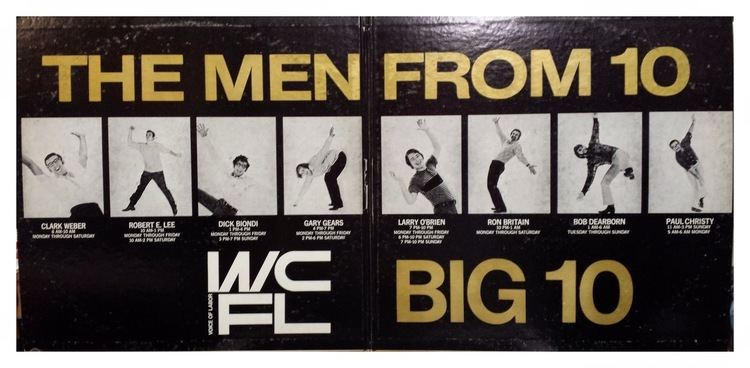
In 1948, the Federation was granted a license for an FM radio station, WCFL-FM on 104.3 MHz. Its transmitter was atop the American Furniture Mart, where WCFL's studios and offices had been located since 1931. WCFL-FM went on the air March 12, 1949, and simulcast its sister AM station's programming for six hours a day–from 3 PM to 9 PM. This time the Federation was impatient for its new radio station to become profitable, having gone from 1926–1940 before WCFL was "in the black". On January 10, 1950, WCFL-FM went off the air permanently; the Federation believed its dollars were better spent for its AM radio station. One of the factors which made WCFL unprofitable in the mid-1970s was the growth of FM Radio; those listening to music were largely doing it on FM stations. Today the frequency is occupied by WJMK, and the call letters belong to a station in Morris, Illinois that is now owned by the Illinois Bible Institute.
During the 1940s, the Federation's thoughts turned once again to television, and in 1953 it applied for VHF channel 11 in Chicago. The Federation lost the bid to the city's educational groups, who would put WTTW on the air in 1955. An early 1960s try netted the Federation a license for Chicago UHF channel 38. In June 1968, plans were made for building a transmitter and antenna atop Chicago's John Hancock Center, as well as other construction needs to get WCFL-TV on the air. By late 1970, the Federation had begun to look at other uses for the station's license which didn't involve the organization. Christian Communications purchased WCFL-TV in August 1975, with the FCC approving the license transfer in early 1976. At the time of the sale, WCFL-TV had yet to be on the air; it became WCFC-TV and, later, WCPX-TV.
The station carried general entertainment over the decades but by the late 1950s WCFL evolved into a popular music station, which had banned all Elvis Presley records from its playlist in late November 1957. The pre-Top 40 talent lineup included Dan Sorkin in the morning, Mike Rapchak (1920–2006) following him and Sid McCoy's all-night jazz program. It was Sorkin who introduced a young Chicago comedian, Bob Newhart, to Warner Bros. in 1959. Bob Elson did both White Sox games and interviewed celebrities at the Pump Room; his sports cohort, Milo Hamilton, also wore two hats, talking football and playing music. Rapchak, who quit on the air in 1965 due to WCFL's new format, returned there in 1978, once again playing big band and jazz music.
Top 40 at the "Voice of Labor"
Between 1963 and 1965, WLS was the only Top 40 station in Chicago. This situation was unusual, as most major cities had two or even three stations featuring pop music. Consequently, WLS had become somewhat complacent as it had no real competitors. This all changed in 1965, when WCFL became a Top 40 music station, competing with WLS. The station also moved from the American Furniture Mart where it had been since 1931, to the then new Marina City, where it remained for the next 20 years. While the station itself was on the 16th floor of the Commercial Building (today the Sax Chicago hotel), WCFL also had a "VIP Room" on the fifth floor where the "WCFL VIPs" (DJ's) hosted various events such as record parties and autograph sessions for listeners who were members of the WCFL VIP Club. One of the station's first promotions was the "Bold" campaign-describing itself as a bold, new way of presenting today's music and its listeners (who wore "I'm Bold!" buttons) as bold enough to want a change.
General Manager Ken Draper ran the station from 1965–1968 and brought many of the original staffers with him from the big Cleveland rock station (KYW/WKYC) he had run before. These included not only DJs but also chief engineer Mike King (later, Jim Loupas), and members of the crack newsroom team, which included the unstoppable Jeff Kamen. WCFL gained fame when Kamen marched into the midst of the 1968 Chicago Democratic convention melee and was beaten by Chicago police, with the picture ending up on newspapers' front pages. Prior to Draper's establishment of an eight-person news department, news was gathered by taking the copy from the station's news wires and reading it on the air.
In their Top 40 years, some famous disc jockeys on WCFL included Jim Runyon (1931–1973), Joel Sebastian (1932-1986), Dick Williamson, (who was already with WCFL at the time of the format change), Jim Stagg (1935–2007), Ron Britain, ("America's First Psychedelic Disk Johnny"), who did a second stint at the station in 1978, the legendary Dick Biondi, (still on the air in Chicago-2010) whose Mutual Radio syndicated Dick Biondi's Young America show was heard here 3 years before his actual arrival, Barney Pip (1994), Ron Riley, Sid McCoy and Yvonne Daniels (1991) with late night jazz during the earliest days of the change to Top 40. In late 1966, WKYC popular afternoon DJ Jerry Ghan (now Jerry G. Bishop)(1936-2013) also decided to follow Draper to WCFL for AM drive. Later, WIND's former long-time morning man Howard Miller (1994), who was a decided departure from the youthful staff, came to helm 'CFL's 6-9AM spot in 1968. He was replaced before long by Clark Weber, long-time WLS-AM morning man.
The DJ secretary during this era was a young lady named Connie Szerszen, who went on to forge her own career on the air in Chicago radio, appearing on WIND and other stations. WCFL General Manager Ken Draper also hired Carole Simpson as one of radio's first female newscasters; Carole went on to a big career with ABC-TV. Also on staff at that time was continuity director Barbara Sternig, who left for LA once the Beatles broke up, became Rona Barrett's writer, and later Senior Reporter in Hollywood for the National Enquirer. Draper is also credited with the introduction of the Sound 10/WCFL survey, which became a competitor to the WLS "Silver Dollar Survey" that station issued weekly beginning in 1960. From 1966–1970, the station produced six "branded" record albums. Later in the SuperCFL-era Larry Lujack (1940-2013) and Art Roberts (2002) came to WCFL.
WCFL's coverage of The Beatles 1965 and 1966 US tours was provided by Jim Stagg, who traveled with the group. The station began a weekly British Countdown program with British DJ Paul Michael, in 1965.
During the late 1960s and early 1970s, WCFL also featured a popular Sunday night program of "underground" album-oriented music called Ron Britain's Subterranean Circus. Due to madcap DJ Britain's sure ear for the innovative and his highly inventive sketches, plus WCFL's powerful AM nighttime signal, these programs gained huge listenership not just in the Chicago area, but in other parts of the country as well. Britain's "Sub Circus" made WCFL one of the few AM stations to feature this kind of music, which was a major staple of "underground" FM stations. The station also supported local bands with its Sunday evening "Chicago Countdown", hosted by Ron Britain, featuring the recordings of Chicago area music groups.
The comedy feature Chickenman, a satire based on the Batman TV series, originated on Jim Runyon's morning drive-time show in the fall of 1966. It was created by WCFL staffer Dick Orkin, who was also brought from Cleveland to Chicago by Ken Draper. All the voices were done by Orkin, Runyon, and Jane Roberts, who also did WCFL's morning traffic reports as "Trooper 36-24-36" (She became Mrs. Jim Runyon.). The Chickenman program was subsequently syndicated to radio stations worldwide.
In August 1968, sales manager Lew Witz replaced Draper as WCFL General Manager. Witz continued to make changes to the station during his tenure. It was Witz who lured Larry Lujack away from WLS in 1972, and the "less talk-more music" philosophy continued. On August 8, 1974, Richard Nixon announced his resignation from the office of President of the United States. The announcement occurred at 8 PM Chicago time, but there was no acknowledgement of it on WCFL's airwaves until 11:30 PM. Witz defended his decision by saying there was ample local and national coverage of the story so there was no need to interrupt the music on WCFL. Gary Deeb, media critic for the Chicago Tribune, blasted Witz in print, saying it was this decision and many others like it that turned WCFL from, "a bright, civic-minded 50,000 watt rock powerhouse into a sonic slum." By the time the station prepared to enter its "Beautiful Music" phase in early 1976, Witz had totally done away with WCFL's news department. Under the management of Witz, the station's turntables used for transferring music onto tape cartridges for broadcast were speeded up from 45rpm to 48rpm. This was meant to make for a "brighter sound" than the station's main rival, WLS-AM and meant that since it was faster, more music could be aired. Witz also insisted his on-air personalities broadcast false time checks, in the event listeners might be part of Arbitron ratings households.
The end of "Super CFL" and the sale to Mutual
On March 15, 1976, after two years of falling ratings, WCFL abruptly dropped its Top 40 format in favor of The World's Most Beautiful Music, leaving WLS once again as Chicago's only AM Top 40 station. Station management released all disc jockeys who did not have "no cut" clauses in their contracts with the official explanation of the format change as "being more in keeping with the labor movement". Larry Lujack, still under contract with the station, stayed on at WCFL playing easy listening music until moving back to WLS in September 1976. This format won few listeners from FM beautiful music stations such as WLOO, and by 1978 had been replaced by a gold-based adult contemporary format.
WCFL and the Chicago Federation of Labor enjoyed the support of Mayor Richard J. Daley throughout his 1955–1976 administration. He proclaimed January 11, 1966 "WCFL Day in Chicago" to mark the 40th anniversary of the station. In 1976, when it became evident it was time for the Federation to sell the radio station, Federation President William A. Lee turned to his long-time friend, Mayor Daley, for advice.
After deciding its profit margin was too small for the Chicago Federation of Labor to maintain, WCFL was sold April 3, 1978 to the Mutual Broadcasting System, which was then a subsidiary of the Amway Corporation. The history of the first and longest-lived labor radio station was over; after nearly 52 years, the "Voice of Labor" had been stilled. The station began to identify itself as "Mutual/CFL." A magazine-type news/talk format was adopted, with sports talk in the evening hours and Larry King overnight, but ratings remained low. In 1982 WCFL changed to an MOR format playing standards and non rock hits of the '50s and '60s mixed in with some softer rock and roll oldies and soft '70s and '80s AC cuts and even a few currents. By the end of 1983, ratings were still low so WCFL evolved into an Adult Contemporary format.
Religious years and end
In 1983, Mutual sold WCFL to Statewide Broadcasting. Statewide switched WCFL to adult contemporary Christian music about 10 hours a day and teaching programs the rest of the time. WCFL basically sold blocks of time to various Christian organizations. The format was profitable but received very low ratings. At that time, they promoted the call letters as standing for "Winning Chicago For the Lord". In early 1985, the station moved from Marina City into a two-story brick building built on its Downers Grove transmitter site. Statewide specialized in religious formats but opted to merge with a secular company called Heftel Broadcasting. WCFL became WLUP-AM (present-day WMVP) just after the stroke of midnight, April 29, 1987. Although no longer in use, the former call letters WCFL, rendered massively in stainless steel, still remain on the exterior wall of the transmitting office, just off 39th Street in Downers Grove.
WCFL on internet radio
J. R. Russ, who grew up listening to the station, has created a cyber version of WCFL which can be heard on the internet at http://www.wcflchicago.com . Russ has been able to obtain original airchecks, commercials and jingles of the station. TM Productions, the producer of radio station jingles since 1955, waived its licensing fees to assist Russ with his historic project. Chickenman, which originated at WCFL, can also be heard. The cyber station went on the air on Labor Day in 2013.
